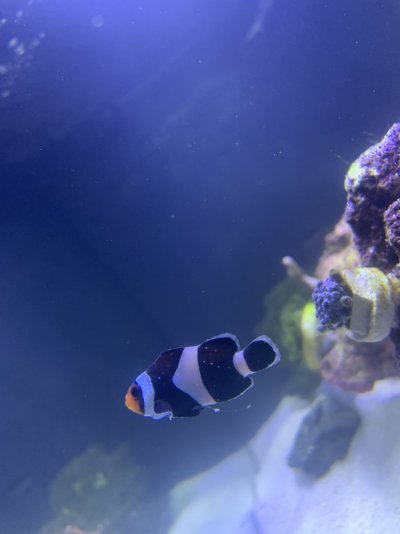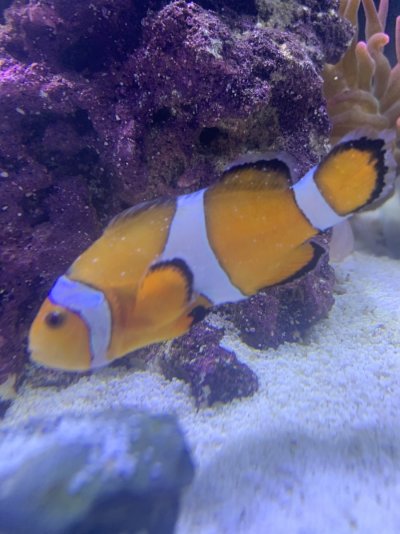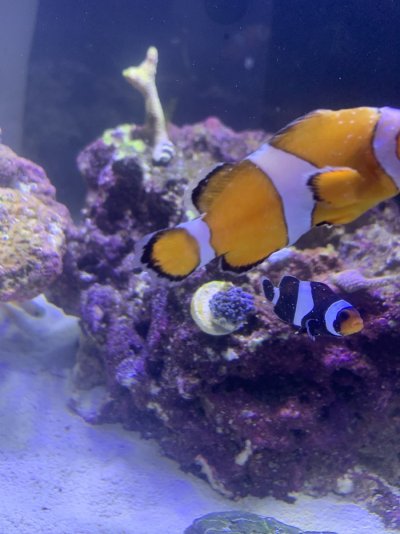I’m new to the whole saltwater world, she had two 55 gallon cichlid tanks and never had an issue, can someone tell me if this is ich in my clown? I’ve never seen it before nor know how to treat it, if anyone can help out thank you!! Small white dots? Almost like small air bubbles?
Navigation
Install the app
How to install the app on iOS
Follow along with the video below to see how to install our site as a web app on your home screen.
Note: This feature may not be available in some browsers.
More options
You are using an out of date browser. It may not display this or other websites correctly.
You should upgrade or use an alternative browser.
You should upgrade or use an alternative browser.
Is this ICH?
- Thread starter tbow
- Start date
- Tagged users None
The video doesn't seem to work. You may also add some still photos to help.
Attachments
vetteguy53081
Well known Member and monster tank lover
View Badges
Partner Member 2024
Excellence Award
Reef Tank 365
RGB
Article Contributor
Tampa Bay Reef Keepers
West Palm Beach Reefer
Hospitality Award
Ocala Reef Club Member
305 Reef Club
Wisco Reefers
Midwest Reefer
Fish Medic
MAC of SW Florida
Rock Pool Reef Keepers
R2R Secret Santa 2023
My Tank Thread
My Aquarium Showcase
Not ich but secondary bacterial lesions associated with brooklynella. The fish is also thin likely due to loss of appetite.I’m new to the whole saltwater world, she had two 55 gallon cichlid tanks and never had an issue, can someone tell me if this is ich in my clown? I’ve never seen it before nor know how to treat it, if anyone can help out thank you!! Small white dots? Almost like small air bubbles?
The thick mucus on its body is a sign which is noticeable on the fish and generally starts at the facial area as well as gills and spreads across the body producing lesions as it progresses often confused with ich and can turn into secondary bacteria. Other symptoms will be lethargic behavior, refusing to eat and heavy breathing from the mucus.
Typical treatment is a formalin solution is mixed with in a separate container with either fresh or saltwater. Start with a quick dip in the formalin at a higher concentration then performing treatment in a prolonged bath of formalin base at a lower concentration in a quarantine tank. The longer the fish are exposed to the formalin treatment the more effective it will be at eliminating this issue.
If a formalin solution is not available for immediate use, temporary relief can be achieved by giving the fish a FW bath or dip in water same temperature as display tank. Even though this treatment will not cure the disease, it can help to remove some of the parasites, as well as reduce the amount of mucus in the gills to assist with respiration problems.
Treatment is best done in a QT tank using either quick cure (more effective but now harder to find) or Ruby Rally Pro. Ruby takes a little longer and initial treatment generally takes 2-3 days to really start going to work.
With the advanced stage of this- I recommend immediate quarantine of all inhabitants and leaving display without fish for 4-6 weeks.
That is marine ich, Cryptocaryon irritans. There *might* be some Brooklynella mixed in, but the spots are definitely ich.
Your two best courses of action would be hyposalinity or coppersafe, but neither of those treatments can be done in aquariums where invertebrates are present.
Jay
Your two best courses of action would be hyposalinity or coppersafe, but neither of those treatments can be done in aquariums where invertebrates are present.
Jay
Similar threads
- Replies
- 6
- Views
- 177
- Replies
- 12
- Views
- 165

















